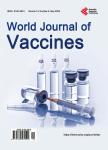Characterization of Influenza H5N1 Nucleocapsid Protein for Potential Vaccine Design
Characterization of Influenza H5N1 Nucleocapsid Protein for Potential Vaccine Design作者机构:Centre for Vaccine Evaluation Biologics and Genetic Therapies Directorate Health Canada-Santé Canada Ottawa Canada
出 版 物:《World Journal of Vaccines》 (疫苗(英文))
年 卷 期:2012年第2卷第3期
页 面:125-142页
学科分类:1002[医学-临床医学] 100214[医学-肿瘤学] 10[医学]
主 题:Quadrant Influenza Therapeutic Vaccine Nucleocapsid Protein Physicochemical Characterization
摘 要:Avian influenza, subtype H5N1, causes occasional but serious infections in humans and efforts to produce vaccines against this strain continue. Current influenza vaccines are prophylactic and utilize the two major antigens, hemagglutinin and neuraminidase. Nucleocapsid protein (NP) is an attractive alternative antigen because it is highly conserved across all influenza strains, has been shown to increase the rate of viral clearance, and potential therapeutic vaccines would elicit cytotoxic T lymphocyte responses in an infected person. The NP antigen from H5N1 was characterized using a variety of physico-chemical methods to gain insights into both the biological and physical properties of the antigen which are important from a regulatory viewpoint when considering therapeutic vaccines. Results obtained to date show that NP is relatively unstable and indicate that the conformation of the H5N1 NP antigen is highly dependent upon purification procedure, buffer conditions, pH and the presence or absence of RNA. These factors will need to be clearly defined and taken into consideration when manufacturing and regulating NP vaccine preparations.



